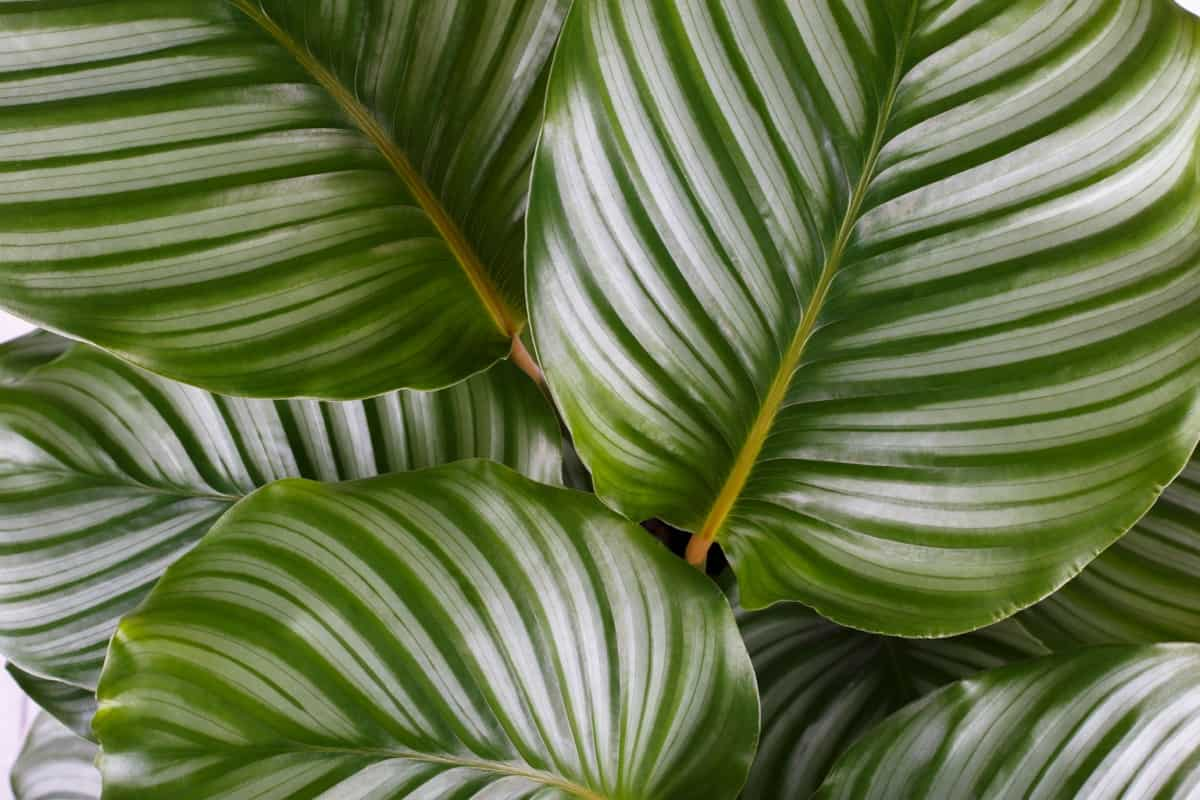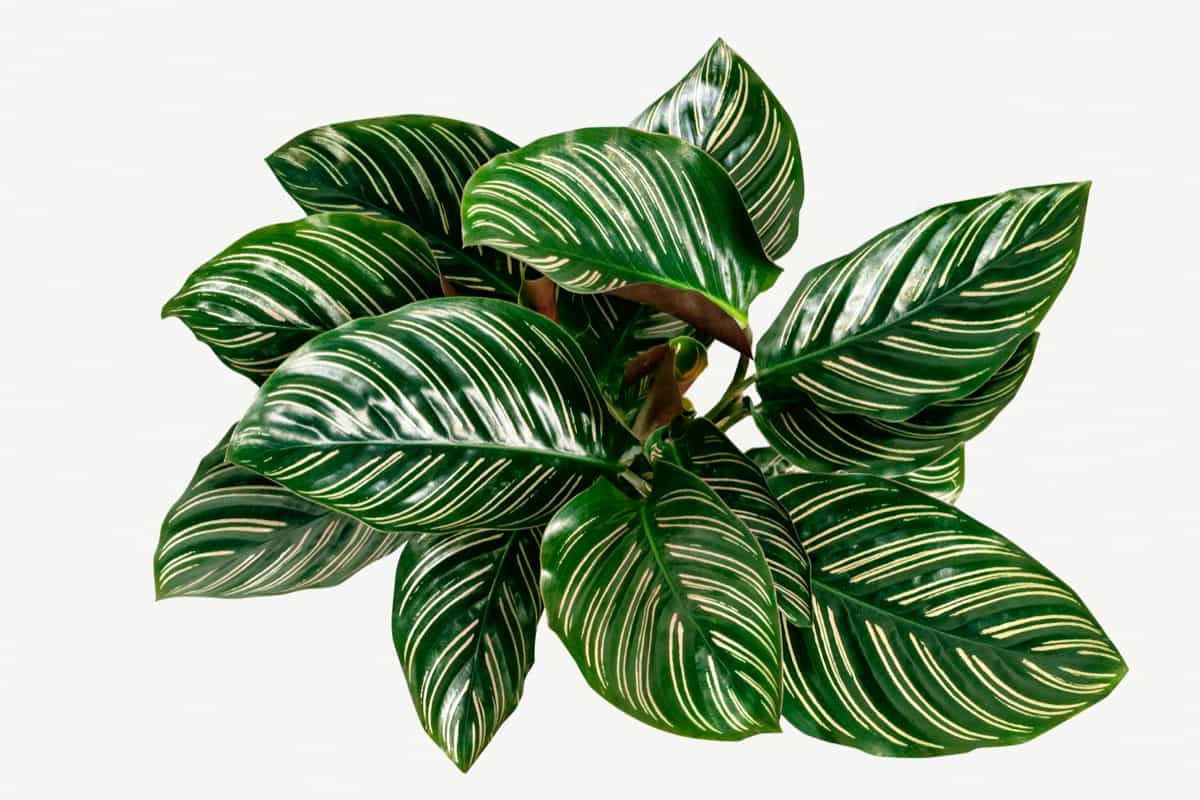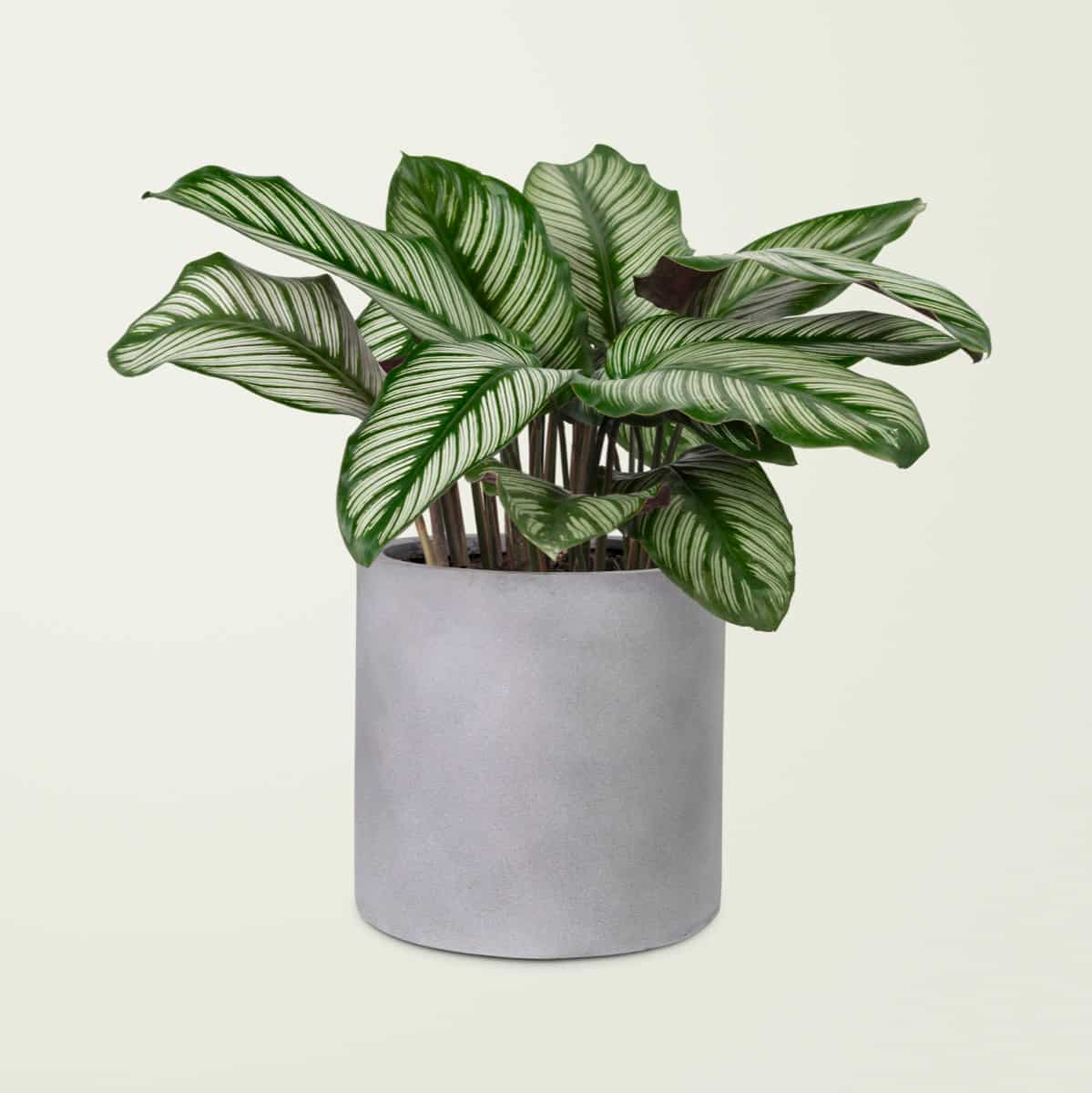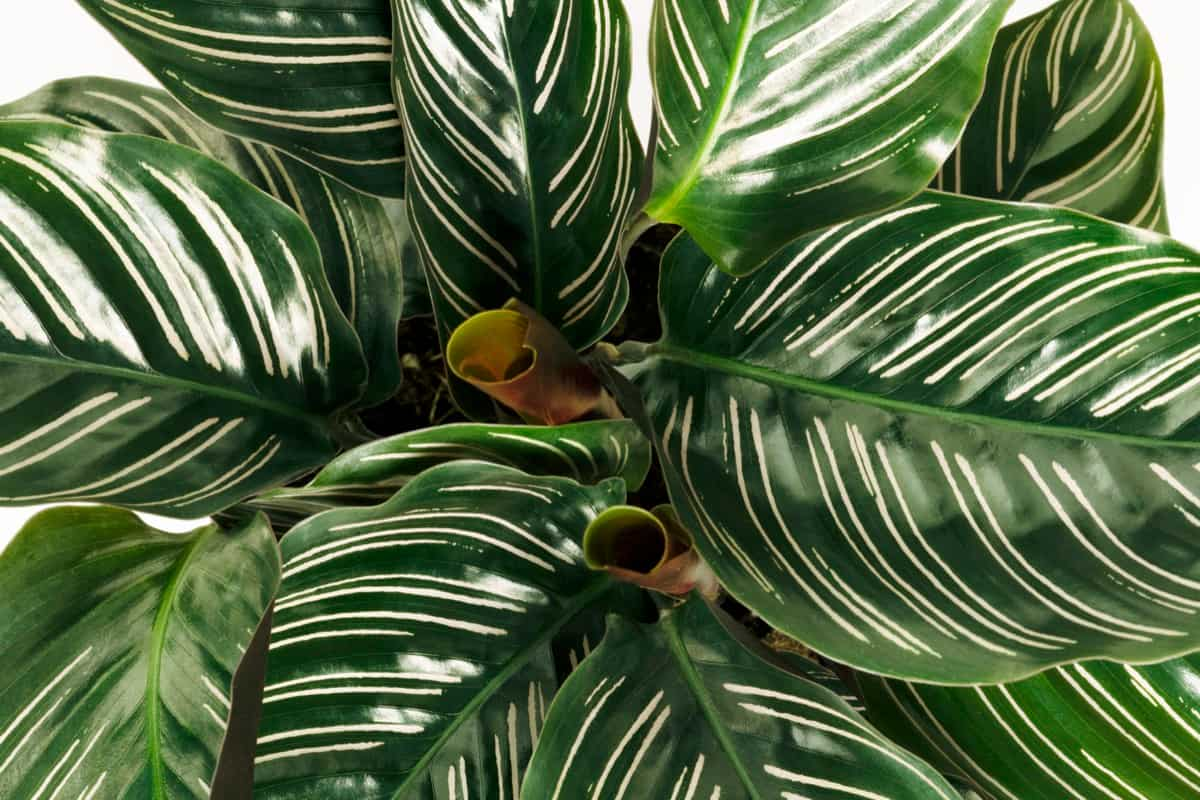Pinstripe plants, also known as Pinstripe Calathea, benefit those who cultivate them. These stunning evergreen perennials are visually appealing with their dark green leaves adorned with delicate white stripes and bring numerous advantages to any indoor space. While the Pinstripe Plant can thrive outdoors in zones 10 and 11, it truly shines when cultivated as an indoor plant.

Growing a Pinstripe plant indoors gives you more control over its growing conditions, allowing you to create the ideal environment for this beauty to flourish. Pinstripe plants are relatively low maintenance and easy to care for. They thrive in indoor settings where you have greater control over factors such as temperature and humidity levels. With proper watering techniques and adequate lighting conditions, these resilient plants will reward you with lush foliage year-round.
Pinstripe Plant Care
Information about Growing Pinstripe
| Common Name | Pinstripe prayer plant, Pinstripe Calathea |
| Family | Marantaceae |
| Light | Bright indirect |
| Soil Type | Rich but well-draining |
| Water | Keep lightly moist |
| N-p-k Ratio | 20-20-20 |
Understanding the Ideal Growing Conditions for Pinstripe Plants
Pinstripe plants prefer indirect sunlight or partial shade. Placing them near a window with filtered light is perfect. Avoid exposing plants to direct sunlight as it can scorch their delicate leaves. Maintaining proper humidity levels is crucial for Pinstripe plants. These tropical beauties love high-humidity environments, so misting their leaves regularly or placing them on a pebble tray filled with water will help create the ideal moisture level. Providing well-draining soil enriched with organic matter will ensure optimal growth for your Pinstripe plant. Good drainage prevents waterlogged roots and allows air circulation around the roots.
In case you missed it: How to Grow Tomatoes in Grow Bags: Planting from Seed, Growing, and Care

Providing Adequate Lighting for Pinstripe Plants
When it comes to lighting, Pinstripe plants thrive in bright but indirect light. They prefer a spot near a window where they can receive filtered sunlight throughout the day. Direct sunlight can scorch their delicate leaves and cause discoloration. To ensure your Pinstripe plant gets the right light, consider placing it on a north or east-facing window sill. These locations provide gentle morning or afternoon sun without exposing the plant to intense midday rays.
How much light does a Pinstripe Plant need? If natural light is limited in your space, you can supplement plants with artificial grow lights specifically designed for indoor plants. Position the lights about 12 inches above the plant and leave them on for 10-12 hours daily. This will help maintain even growth and prevent straggly-looking foliage.
Maintaining the Temperature and Humidity Levels for Pinstripe Plants
It is crucial for their overall health and growth. These tropical plants thrive in warm, humid environments that mimic their natural habitat. Paying attention to temperature and humidity is important to ensure optimal conditions. Pinstripe plants prefer a range between 18-27°C. They are sensitive to cold drafts or sudden temperature drops, so keep them away from windows or doors that may let in chilly air. Avoid placing them near heating vents, as this can lead to dryness.
In case you missed it: Growing Peppers in Grow Bags: Planting from Seed and Care

Do Pinstripe plants like humidity? Pinstripe plants require high levels to thrive. Aim for a relative humidity of at least 50%, ideally closer to 60-70%. You can increase humidity levels by misting the leaves regularly with room-temperature water or using a humidifier nearby. To maintain proper moisture levels, it’s also essential not to overwater or underwater your Pinstripe plant. Regularly check the soil and ensure good drainage using a well-draining soil mix.
Proper Watering Techniques for Pinstripe Plants
- Watering Frequency: Pinstripe plants generally need to be watered once or twice a week during the growing season. However, adjust the frequency based on factors like humidity levels and temperature in your environment.
- Water Amount: When you water, thoroughly saturate the entire root ball until excess water drains out from the bottom of the pot. This ensures that all roots receive adequate hydration.
Fertilizing Pinstripe Plants: Tips and Recommendations
It’s important to choose the right fertilizer for these tropical beauties. Select a balanced, water-soluble fertilizer with an N-P-K ratio of Pinstripe plants is 20-20-20 or something similar. Feed your Pinstripe plant every two weeks during the growing season, typically spring to summer. This will provide it with the necessary nutrients to fuel its growth. However, during winter, when growth slows down, reduce the frequency of fertilization to once a month.
In case you missed it: How to Grow and Care for Organic Komatsuna: Planting Instructions

Remember not to over-fertilize your Pinstripe plant, which can lead to the plant roots burning and foliage. Always follow the instructions carefully on the fertilizer package. In addition to regular feeding, consider supplementing with organic matter. These natural additives can enhance soil fertility and improve overall plant health.
Pruning and Propagating Pinstripe Plants
When it comes to pruning, removing any yellowing or brown leaves is best, as they can be a sign of stress or disease. Use sharp scissors and make clean cuts close to the base of the leaf stem. To propagate your Pinstripe Plant, you have a few options. One method is by division, where you carefully separate the plant into smaller sections with their root systems.
Another option is stem cuttings – take a healthy cutting from the mother plant and place it in water or soil until roots develop. Remember to properly care for your propagated plants as they establish themselves in their new environment. This includes maintaining consistent moisture levels and providing adequate light.
Dealing With Common Pests and Diseases in Pinstripe Plants
One common pest that can affect Pinstripe plants is spider mites. These tiny arachnids can quickly infest your plant, causing yellowing leaves of Pinstripe plants and webbing on the foliage. To combat spider mites, regularly mist your plant with water to increase humidity, as these pests thrive in dry conditions. Also, you can use insecticidal soap or neem oil spray to control their population. Another pest that may bother your Pinstripe plant is mealybugs.
In case you missed it: How to Grow and Care for Organic Horehound: Planting Instructions

These small white insects feed on the plant sap, causing stunted growth and honeydew secretion. To eliminate mealybugs, wipe them off using cotton dipped in rubbing alcohol or use an organic insecticide specifically formulated for mealybug control. Fungal diseases can also affect Pinstripe plants if they are overwatered or exposed to high moisture levels. Prevent these diseases by ensuring proper drainage in your pots and avoiding overwatering.
If you observe any signs of fungal infection, remove affected leaves immediately and treat the plant with a fungicide recommended for ornamental houseplants. Remember that disease prevention is key when dealing with pests and diseases in Pinstripe plants. Regularly inspect your plants for any trouble, provide optimal growing conditions, and promptly address any issues. Doing so ensures that your Pinstripes stay vibrant and healthy all year round.
Pinstripe Leaves Browning and Curling: What is Causing It and How to Fix It?
One common issue that Pinstripe plant owners may encounter is the browning and curling of the leaves. This can cause concern, indicating something is wrong with the plant’s growing conditions. Several factors could contribute to this problem. One possible cause is improper watering techniques. Overwatering the soil to become too dry can lead to leaf damage. To fix this, ensure you provide adequate moisture without overdoing it. Keep the soil moist but not waterlogged, and ensure proper drainage so excess water can escape.
In case you missed it: How to Grow and Care for Organic Horehound: Planting Instructions

Another potential cause is inadequate lighting. Pinstripe plants thrive in bright indirect light, so their leaves may start to brown and curl if placed in a spot with insufficient light or direct sunlight. Move your plant to a brighter location away from direct sunlight but still within its preferred range of lighting conditions. Temperature fluctuations can also affect leaf browning and curling in Pinstripe plants.
Plants prefer temperatures between 18-24°C, so exposure to cold drafts or extreme heat can stress the plant and lead to leaf damage. Ensure your Pinstripe plant is kept away from drafty windows or heating vents, maintaining a consistent temperature throughout its surroundings. Humidity levels may affect your Pinstripe plant’s health. These tropical plants thrive in high-humidity environments similar to their natural habitat. Dry air can cause leaves to dry out and curl up at the edges while increasing humidity levels will help keep them healthy-looking.
In case you missed it: How to Grow and Care for Organic Fenugreek: Planting Instructions

Conclusion
The Pinstripe plant is a stunning evergreen perennial that belongs to the Marantaceae family. This plant adds beauty to any indoor space with its distinctive dark green leaves adorned with pink stripes and burgundy undersides. It has gained popularity among houseplant enthusiasts for its unique foliage patterns and relatively low maintenance requirements.
- Where to Place Indoor Plants in Your Home
- How to Grow Tomatoes Organically at Home: A Comprehensive Guide
- Organic Gardening on a Budget: Low-Cost Methods and Materials
- Gongura Seed Germination and Planting Methods
- Cabbage Seed Germination and Selection
- Broccoli Seed Germination and Selection
- Asparagus Seed Germination and Variety Selection
- Seasonal Flower Gardening: Best Practices for Spring, Summer, Fall, and Winter
- How to Grow Hibiscus from Flower
- Plantation Ideas for Home Decoration: A Beginners Guide
- Flower Garden Designs and Layouts for Beginners
- Planting and Spacing Techniques in Papaya: A Beginner’s Guide
- Growing Gold: Essential Techniques for Planting Pineapples
- How to Make Kalanchoe Plant Bushy: Home Remedies and Solutions
- 11 Reasons Why Your Gardenia is Not Blooming: Home Remedies and Solutions
- Eco Elegance: The Guide to Designing a Drought-Tolerant Landscape
- Gardening on a Slope: Strategies for Hillside Landscaping
- Nourish and Flourish: Top Organic Mulches for Thriving House Plants
- Everything You Want to Know about Indian Mogra Flower: Discover Uses and Growing
- Green Thumb Success: Expert Tips for Cultivating Greenhouse Pumpkins All Year Round
- Maximize Growth & Flavor: The Ultimate Guide to Companion Planting in Herb Gardens
- How to Control Rhododendron Problems Naturally: Home Remedies and Organic Ways to Fix Them
- Natural Magic: The Remarkable Benefits of Cinnamon for Plants
- Best Steps to Revive Dying Tulip with Natural and Organic Treatment
- 10 Reasons Why Your Angel Trumpet is Not Blooming: Remedies and Treatment
- How to Fix Periwinkle Leaf and Flower-Related Problems: Natural Remedies and Solutions
- How to Fix Zinnias Leaf and Flower Problems: Discover Natural and Home Remedies
- Organic Steps to Induce Lemon Tree Flowers: A Comprehensive Guide
- Bloom Booster: Crafting the Perfect Homemade Bougainvillea Fertilizer
- Optimizing Growth: A Guide to Applying NPK Fertilizer for Potted Plants
- 10 Best Homemade Fertilizers for Rubber Plant: DIY Recipes and Application Method
- How to Boost Female Pumpkin Flowers: Effective Steps for More Flowers and High Yields
- Transform Your Indoor Garden: Top Benefits of Pink Salt for Houseplants
- 10 Best Homemade Fertilizers for Peacock Plants (Calathea): Easy DIY Guide
- Unlock Blooms: 9 Reasons Why Your Potted Chrysanthemum is Not Blooming
- 8 Reasons Why Your Potted Hibiscus is Not Blooming: Fix it with Simple Solutions